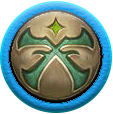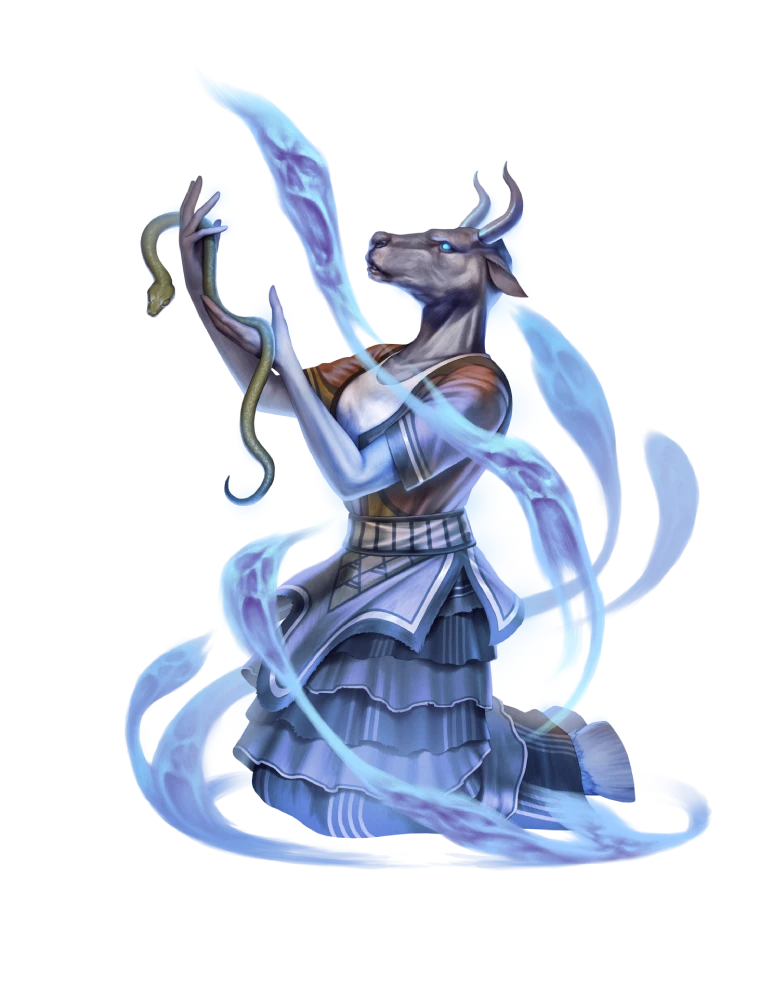
Minotaur
 Uncommon Beast Humanoid Minotaur Source Howl of the Wild pg. 41 2.1Minotaurs are horned, bovine humanoids who originate from an ancient divine curse. Minotaurs are large, strong, and masters of crafts and puzzles, inclinations that lead many minotaurs to explore architecture and stonework. Minotaurs are most at home in labyrinths, whether natural, artificial, or psychological.
Uncommon Beast Humanoid Minotaur Source Howl of the Wild pg. 41 2.1Minotaurs are horned, bovine humanoids who originate from an ancient divine curse. Minotaurs are large, strong, and masters of crafts and puzzles, inclinations that lead many minotaurs to explore architecture and stonework. Minotaurs are most at home in labyrinths, whether natural, artificial, or psychological.Minotaurs stalk complex passageways, whether natural or artificial, and are masters of stone architecture. Inquisitive and steadfast, these bovine humanoids spend their lives perfecting the pursuit that calls to them, which can sometimes lead them far from the enclaves where they were raised. Minotaurs are originally from the Iblydos archipelago but have spread far and wide across Golarion, forming close-knit communities often near mountains or beneath the surface of the earth. Though sometimes mistaken for simple brutes, minotaurs have scholars and warriors alike. Those who can look past their appearance will find an affinity for building and navigation, as well as creative problem-solving.
The myth many minotaurs tell of their origins is one of craft, curses, and misunderstanding. Millennia ago, Iblydos was filled with living deities who walked among and ruled the mortal people. A stonemason named Tavdrinos, admired by mortals and hero-gods alike, received a vision from a hero-god to create a glorious temple, though the myth doesn't name which one. The mason found the images of the vision murky: scrambled glimpses of twisting columns, charging bulls, and a defiant stand made by an unknown figure. It was hardly a detailed commission, but one does not refuse a divine order. The mason labored for 17 years before his task was done. The three-story temple celebrated the glory of the hero-god and their sacred animal, the bull. Upon the hero-god's arrival, Tavdrinos expected to be met with praise and congratulations, but the deity flew into a rage instead. Tavdrinos had misunderstood the vision, for the bull was a hated beast, not a celebrated ally. As punishment for this accidental insult, the hero-god cursed Tavdrinos with the hated shape of the bull. Angered by both the curse and his failure to please the deity, the mason retreated to a series of caves under the temple, where he continued his work as the first minotaur.
If you want to play a character with strength of body, who expresses themselves through craft more than words, you should play a minotaur.
You Might...
- Decorate your hooves and horns with designs or colors of personal significance.
- Be adept at navigation and puzzles.
Others Probably...
- Be intimidated by your size or think you calculating.
- Think you can see through stone.
Physical Description
Minotaurs are tall, bulky humanoids with the bovine features such as horns, hooves, and elongated faces. Their fur patterns are frequently monotone in deep browns or blacks, though white or gray aren't uncommon. Though the large size of a minotaur might cause one think they are clumsy, the truth is quite the opposite. Minotaur hooves rest on a delicate balance point, making their footfalls quiet and precise. However, when there is a need to be heard, the steps of a minotaur can fall like thunder.
A minotaur's horns are a source of pride and often accented by pieces of fashion. Those with longer horns add rings and chains around them, cast in whatever rare metals are affordable, or dye or engrave patterns along them. Those with not much horn to speak of instead shave their fur around the base of the horns, possibly adding stylish circular tattoos to the surrounding skin or fitting metal caps onto their tips. This draws attention to an otherwise overlooked feature.
Society
Minotaurs typically reside within insular, subterranean communal enclaves. They take great pride in their architectural prowess, hewing buildings out of stone and natural caves alike. An enclave often has almost twice as many buildings as it needs, with the extra structures serving as functional art. Young minotaurs practice their hunting and stalking skills in the empty buildings, with each generation adding a small expansion or fresco on the walls. Expansions like twisting hallways, unexpected overhangs, shared gardens, and a variety of other such contrivances create numerous social spaces and quiet areas for calm reflection, so long as the traveler is able to keep from becoming lost by the unusual architectural flow.
Myths surrounding minotaurs lead most to believe they are fierce carnivores, or even cannibals in the darkest of legends. In reality, most minotaur societies are hunter-gatherers, feeding off lichen and other flora. Their reputation as fierce hunters stems from monthly rituals, when the most accomplished stalkers venture out and bring back dangerous prey. The return of these hunters is one of the few occasions minotaurs indulge in meat, feasting on the kills as a show of gratitude and reverence for the hunters' skills.
Minotaurs tend to be blunt and literal, rarely engaging in overly clever wordplay, sarcasm, or irony. Flaring nostrils and rolling eyes can be intimidating expressions when viewed by non-minotaurs, but to a minotaur, they can convey a complex story with emotional and even spiritual elements. Minotaurs wishing to emphasize a certain emotion occasionally use piercings and tattoos, though minotaurs who lean too heavily into these adornments to look fierce often come off as a bit foolish to their peers. The minotaur saying “an angry bull stamps once and gores twice” is both an admonition against overly aggressive displays and a reminder that the creature truly to be feared is one who speaks with their actions.
Beliefs
Long traditions of isolation have resulted in most minotaurs taking an evenhanded approach to events. Many tend toward an unbiased outlook that allows for adaptation. Those who have poor interactions with other humanoids, particularly those met with violence or intolerance, might choose to recede into a chosen lair, ruin, or fortification that they guard fiercely, which sadly perpetuates the tales of brutal minotaurs.
Minotaurs raised by their own people tend to avoid association with deities of any stripe—little surprise given their creation legend. Divine beings are thought of as petty and uncaring, if not by intent then by the sheer magnitude of their power. Many minotaurs adopt logical or spiritual philosophies as a way of reconciling their existence. Mysteries are puzzles yet unanswered, ones that can be explained with careful thought and study. When minotaurs decide to follow deities, they're primarily drawn to those concerned with self-improvement and self-control, like
Irori and
Nethys.
Popular Edicts construct architecture of lasting beauty, seek out ever more perplexing puzzles, hone one's prowess
Popular Anathema leave fate to godly hands rather than mortal initiative, pass up the chance to investigate a mystery
Adventurers
Minotaurs have a reputation for being fearsome melee combatants. While this can be true, and there's no shortage of
barbarians or
fighters among minotaur adventurers, a minotaur can do very well in many classes. The keen mind and love of puzzles produces many an
investigator and
wizard, while minotaurs with a taste for the unique find themselves walking the path of an
inventor or
thaumaturge. The ancestry's affinity for earth and stone can also lead them to join the ranks of
druids or
sorcerers of the elemental bloodline. Those who wield the divine typically do so by honing inherent power as sorcerers or
oracles rather than by supplicating to a higher entity as
clerics or
witches.
Names
Iblydan minotaurs often have names similar to the names of humans from that archipelago. Minotaur surnames are ever-changing, typically reflecting the most memorable achievement an individual has accomplished. Until adulthood, an Iblydan minotaur bears the surname Tavdrinos (after the first minotaur). Once they reach maturity, their childhood friends and allies collectively bestow a fitting surname. Minotaurs in adventuring groups might be renamed multiple times by their allies.
Sample Names
Actilea, Iraiasos, Paxaidio, Rotherion, Zavmandris
Other Information
Minotaurs and Other Ancestries
The desire to learn has caused minotaurs to wander far and wide, and as such, they can be encountered far from their original home of Iblydos. Preferring mountainous or underground regions, minotaurs who put down roots often live with ancestries of a like mind, such as
dwarves,
hobgoblins, and
orcs. The nation of Oprak in the Inner Sea has a small subculture of minotaurs that assist with engineering works across the Mindspin Mountains.
Some minotaurs who migrated east from Iblydos made it as far as the islands of Minata in Tian Xia, where they were surprised to encounter another bovine ancestry known as sarangay. The first interactions revealed a clear separation between the cultures: sarangay took pride in their origins, while minotaurs strove to move past theirs. Whenever a minotaur is mistaken for a sarangay, they politely point out the many differences with a good-natured chuckle.
The Minotaur Prince of Absalom
Nuar Spiritskin was born in an enclave of minotaurs within the Kortos Mounts. Smaller in stature than his siblings and with unusually white fur, Nuar relocated to the city of Absalom after being banished by his kin. In a chance encounter, he rescued the primarch from being assaulted by angry sailors and was then given the honorific title of the Minotaur Prince of Absalom. He now resides in a lavish compound called the Taurean Embassy, from which he attempts to rekindle ties with his enclave.
Minotaur Mechanics
Hit Points
10
Size
Large
Speed
25 feet
Attribute Boosts
Strength
Constitution
Free
Attribute Flaw
Charisma
Languages
CommonJotunAdditional languages equal to your Intelligence modifier (if positive). Choose from
Cyclops,
Dwarven,
Fey,
Petran,
Sakvroth, and any other languages to which you have access (such as the languages prevalent in your region).
You can see in
darkness and
dim light just as well as you can see in
bright light, though your vision in darkness is in black and white.
Horns
Your sharp horns are as deadly as spears. You have a horns unarmed attack that deals 1d8 piercing damage. Your horns are in the
brawling group and have the
unarmed trait.